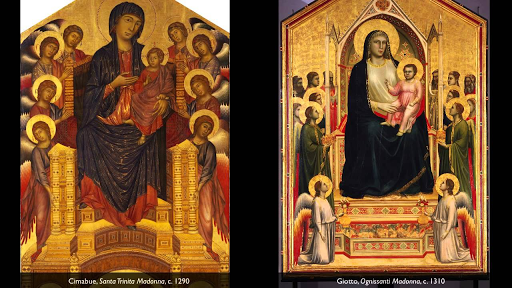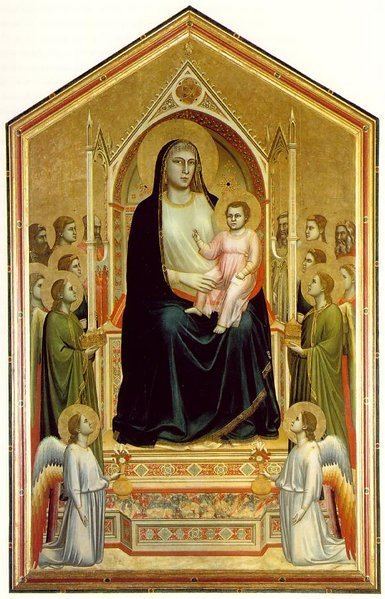Year c. 1310 Created 1306 Media Paint, Tempera | Medium Tempera on panel Dimensions 3.25 m x 2.04 m Subject Madonna | |
 | ||
Similar Giotto artwork, Artwork at Uffizi Gallery, Tempera | ||
Giotto the ognissanti madonna
Madonna Enthroned, also known as the Ognissanti Madonna, is a painting by the Italian late medieval artist Giotto di Bondone, housed in the Uffizi Gallery of Florence, Italy.
Contents
- Giotto the ognissanti madonna
- Cimabue santa trinita madonna giotto s ognissanti madonna
- Influences
- Technique
- References

The painting has a traditional Christian subject, representing the Virgin Mary and the Christ Child seated on her lap, with saints and angels surrounding them on all sides. This particular representation of the Virgin is called a Maestà, a popular representation at the time. It is often celebrated as the first painting of the Renaissance due to its newfound naturalism and escape from the constraints of Gothic art.

It is generally dated to around 1310. While historians have had trouble finding specific information for indisputably attributing many of Giotto's works to the artist, Madonna Enthroned is one piece for which there are a few documents supporting its creation by Giotto. There are many sources that show he spent many years living and creating in Florence. However, the main source that documents Madonna Enthroned specifically is artist Lorenzo Ghiberti's autobiography, I Commentarii (1447). An earlier manuscript document of 1418 also attributes the painting to Giotto, but it is Ghiberti's autobiography that provides the most solid evidence.

One of Giotto's later works, Madonna Enthroned was completed in Florence, upon the artist's return to the city. It was originally painted for the Ognissanti Franciscan church in Florence. Built for the Humiliati, a small religious order at the time, the church had many acclaimed paintings designed for it. Specifically, Giotto's Madonna Enthroned was designed for the high altar.

Cimabue santa trinita madonna giotto s ognissanti madonna
Influences

The Madonna Enthroned shows the numerous styles of art that influenced Giotto. In both the gold coloring used throughout the artwork and the flattened gold background, Giotto's art continued the traditional Italo-Byzantine style so popular in the proto-Renaissance time period. The altarpiece represents a formalized representation of an icon, still retaining the stiffness of Byzantine art, and Giotto retained the hierarchy of scale, making the centralized Madonna and the Christ Child much larger in size than the surrounding saints and religious figures.

Giotto's figures however escape the bounds of Byzantine art. His figures are weighty and are reminiscent of three-dimensional sculptures, such as that in classical Roman sculpture. The Madonna's intricately decorated throne, which itself is an Italian Gothic design, has a very specific use of colored marble as a surface decoration. This use of marble was a style that ended in the early Christian time period, and thus gives a clue that Giotto was knowledgeable of art of that time period.

There were, additionally, a number of specific artists whose styles heavily influenced The Ognissanti Madonna. The influence of Cimabue, traditionally recognized as Giotto's teacher, is shown first in the very symmetrical composition of the piece. Cimabue portrayed the same subject in his 1280 Virgin and Child Enthroned, and both pieces share aspects of the Italo-Byzantine style, with Cimabue's having more Byzantine attributes. Additionally, the two depictions of the angels' wings in Giotto and Cimabue's pieces clearly resemble each other. Both pieces share a similar, initial feeling of severity, yet there is more to each piece than the drama. Giotto adopted from his teacher the importance of, and the concern for, volume and forms in space.
The tranquility of Giotto's figures resembled also the style of Pietro Cavallini. From this artist, who painted neo-Byzantine pieces, taking cues from both mosaics and frescos from Roman and Early Christian times, Giotto took important lessons in the technique of painting, and in rendering figures as statuesque and calm.
Lastly, Giotto took cues from many contemporary sculptors, including Nicola and Giovanni Pisano, whose work shares influences of Northern Gothic art. In the work of these artists, Giotto saw great, dramatic compositions that would certainly influence his Ognissanti Madonna.
Technique
Giotto was the first artist to depict three-dimensional figures in western European art. Additionally, he used a much smaller space than other contemporary artists, further emphasizing the importance of the bodies in the artwork. Giotto did away with many aspects of Byzantine art that would flatten the painting. Within Cimabue's Virgin and Child Enthroned, there is the use of gold tracing to delineate the folds of the fabric. In contrast to this, Giotto's fabric folds are more realistic, and instead of lines he used light, shadow, and color to create the appearance of fabric. Contours of the body underneath these fabric folds are also visible, specifically in the Virgin's knees and also around her breasts.
Giotto used a value scale, a distinct range of light and darks, to create a sense of volume in his figures, giving them the slight smokiness that is usually characteristic of Leonardo da Vinci and later Renaissance artists.
